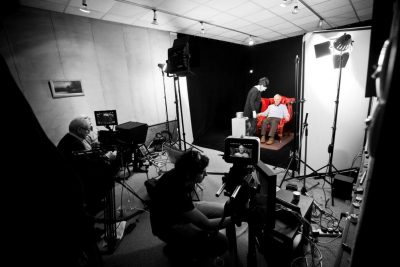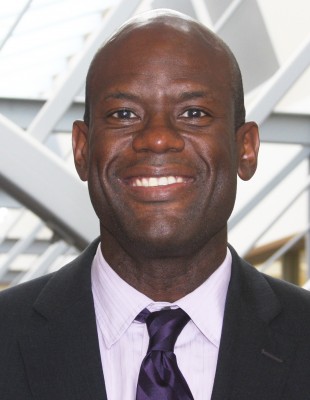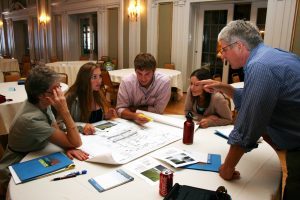Daily News (Joseph Renzulli and Sally Reis write original commentary about the elimination of gifted education programs in NYC’s public schools)
Greenwich High Scholastic’s Teacher Wins Economic Education Award
Patch (Neag School alumnus Ian Tiedemann recognized with the Alfred P. Sloan Foundation Teaching Champion Award)
If New York City Eliminates Gifted Programs, Here’s What Could Come Next
Chalkbeat (Sally Reis and Joseph Renzulli are referenced)
The Future of Holocaust Education: Virtual Survivor Testimony in 3D

As the number of Holocaust survivors worldwide continues to dwindle each year, the question of how to preserve the stories of survivors as a means of remembrance and education becomes ever more relevant. Alan Marcus, associate professor in curriculum and instruction, is working to answer that question through research on three-dimensional, interactive technology. Along with a team of researchers, Marcus has embarked on “The Forever Project: The Benefits and Dilemmas of Using Virtual Interactive Survivor Testimony.”
Ian McGregor, a Ph.D. student in curriculum and instruction at the Neag School, and Rotem Maor, a former curriculum and instruction postdoctoral student, along with faculty from the University of Wisconsin-Madison, Virginia Tech, and the University of Nottingham, join Marcus on the project.
This year, The Forever Project received a $50,000 grant from The Spencer Foundation that will allow it to continue its work with The National Holocaust Centre and Museum in England. The research team has taken several trips to the U.K. over the past year and a half to see how Virtual Interactive Holocaust Survivor Testimony (VIHST) is being implemented and understand how museum staff, educators, and participating students are reacting to it. VIHST uses 3D technology to present a digital representation of the survivor, allowing students to see and hear the survivor tell their story and then ask him or her questions with the help of museum staff and the latest technology.
“We are looking at how we can think as a field, both historians and educators, about using virtual technology as a tool in the future, not just with the Holocaust, but with any kind of survivor of an atrocity,” says Marcus. “We are looking to see what the ethical issues are and how to potentially use survivor testimony effectively in terms of education.”
Virtual Interactive Holocaust Survivor Testimony uses 3D technology to present a digital representation of the survivor, allowing students to see and hear the survivor tell their story and then ask him or her questions with the help of museum staff and the latest technology.
More Than a Video Recording
The virtual technology has presented several ethical questions for the Forever Project team, such as whether or not it is acceptable to edit survivor testimony or if the nature of how students ask the survivor questions takes away from some of their inquiry. The Spencer Foundation grant has given the team the opportunity to explore those questions further.
According to Marcus, the University of Southern California Shoah Foundation was the first to experiment with virtual survivor technology in their project, “New Dimensions in Testimony.” The National Holocaust Centre later tried the new form of survivor testimony, while using different technology and a different approach. Both institutions aimed to preserve survivors’ stories in 3D, rather than simple video recordings.
“They wanted a way to preserve their testimony that wasn’t just staring at a screen and being talked at,” says Marcus. “It developed in these two places, but no one really knew if it was effective or how to use it with students or at a museum or anywhere. That’s where our research team comes in.”
In the U.K., the Holocaust Centre filmed 10 survivors in anticipation of launching VIHST technology in its museum.
“I was already doing a lot of work at the Holocaust Centre in England as this project was being developed, and I asked, ‘Well, how does it work? What are the ethical issues? How are you going to do this with students?’” says Marcus.
From an Initial Curiosity to a Global Project
Marcus says he had to begin The Forever Project through small, working stages.
It was January 2018 when The Forever Project team set out for the U.K. Holocaust Centre to become familiar with VIHST. Marcus credits the Neag School Dean’s Office with providing the initial financial support needed to launch the project, via a $10,000 Dean’s Research Incentive Award.
“The dean’s money allowed me and other members of our research team to go to England and have everyone see the virtual workings, both for ourselves and with students,” says Marcus. “It helped us do the first round of data collection with all the museum staff who put this project together and with the survivors who participated.”
UConn’s Office of Global Affairs also provided $4,000 in funding that assisted with the initial 2018 trip.
So far, the team has undergone two rounds of data collection, one with museum staff and survivors and one with students.
- Round 1 (June 2018): The initial round was geared toward understanding the perspectives of the 10 survivors filmed by the Holocaust Centre staff. The Forever Project team was able to interview six of them to find out why they participated and what they expected the results to be. The museum staff was asked questions about why they developed VIHST and how were they making decisions on how to use it.
- Round 2 (June 2019): The second round, funded by the Spencer Foundation grant, aimed at comparing the impacts of virtual survivor testimony with live survivor testimony. The team collected data on 400 middle- and high school-aged students who were split into groups, some of which were presented with the virtual survivor testimony and some of which were presented with the live survivor. Through short pre-and post-surveys and focus groups, Marcus says the team was looking to understand what students think of the technology, whether they are able to develop the same level of empathy with the virtual survivor as they would with the live survivor, and whether they questioned the trustworthiness of the virtual source, among other questions.
Marcus says once the team has analyzed results from the second round of data collection, they may return to the U.K. to have the museum staff make some adjustments and conduct additional research.
Beyond the U.K., The Forever Project team has established a second research site at the Illinois Holocaust Museum Education Center, whey they have begun filming virtual survivors, and also a third site in Munich, Germany.
Creating Good Global Citizens
While the project’s focus is on effective Holocaust education, Marcus emphasizes the impact of history education on developing students into “participatory global citizens.” Historical events such as the Holocaust lead students to question how they treat other people and how they will live their lives as adults, he says.
“The Holocaust gives us examples of a lot of really bad in the world but also a lot of really good. There were a lot of people who rescued people, hid people, and risked their lives to save people,” says Marcus. “I think it’s a good model for students that really gets them thinking.”
Marcus said Holocaust education must be reinforced throughout students’ history education to allow them to reflect on their individual actions and question what is currently happening in society.
“Students don’t become good citizens in democracy from one Holocaust [educational] unit. It’s got to be part of everything they do,” says Marcus.
Learn more about the Forever Project.
Related Stories:
The State’s New Education Commissioner: Collaborator, Listener, Hard Worker
CT Mirror (Neag School alumnus and Connecticut’s new commissioner of education, Miguel Cardona, is profiled)
Anatomy of a Charter School Fraud
Have You Heard Podcast (Preston Green interviewed at 23:10)
Green Named John and Maria Neag Professor of Urban Education

Professor Preston Green III was formally appointed the John and Maria Neag Professor of Urban Education on Aug. 14. A renowned expert in education law who joined the Neag School’s Department of Educational Leadership in 2013, Green also holds a joint appointment in UConn’s School of Law.
In addition to disseminating his work via many high-caliber scholarly journals and five published books, Green has his research cited regularly in national publications that include The Washington Post, Business Insider, The Atlantic, and American Prospect. He also is consistently interviewed by and quoted in a broad range of prominent media outlets, among them The New York Times, The Wall Street Journal, Chalkbeat, and the Boston Globe, while also writing and co-writing original pieces for such outlets as The Conversation and The Century Foundation. Green, whose expertise centers on the areas in which education and law intersect, publishes and presents on the topics of charter schools, educational policy, and school choice. A 2017 paper he co-authored titled “Are Charter Schools the Second Coming of Enron?” has led Green to become one of the go-to experts in the nation on the oversight of charter schools.
At UConn, Green helped develop the UConn Administrator Preparation Program in Law, which enables participants to obtain a law degree and school administrator certification at the same time. He also developed UConn’s School Law Online Graduate Certificate, an online program that helps educators, administrators, and policymakers understand the legal dimension of K-12 education.
“Dr. Green serves as a leading, highly sought-after expert and speaker, a prolific and pioneering researcher, and an innovative faculty scholar.”
— Neag School Dean Gladis Kersaint

“Thanks to the support of our benefactors, the Neag School is very pleased to bestow this honor to Dr. Green for his exceptional ongoing work,” says Dean Gladis Kersaint. “Dr. Green serves as a leading, highly sought-after expert and speaker, a prolific and pioneering researcher, and an innovative faculty scholar.”
Prior to his arrival at UConn, Green was the Harry Lawrence Batschelet II Chair Professor of Educational Administration at Penn State, where he was also a professor of education and law as well as the program coordinator of Penn State’s educational leadership program. There, similar to his endeavors at UConn, he created Penn State’s joint degree in law and education. He also ran a professional development program on educational law known as the Law and Education Institute at Penn State. From 1995 to 2003, he served in various roles at the University of Massachusetts at Amherst.
Green earned his J.D. and Ed.D. from Columbia University and completed his BA in government at the University of Virginia.
Related Stories:
Register for the 2019 Special Education Summit
$2.5M NSF Grant to Study Online STEM Course Outcomes
City University of New York (Christopher Rhoads co-PI on new grant)
Neag School Part of $2.25M NSF Grant for ‘Environment Corps’ Project

Editor’s Note: The following piece was originally published by the UConn Extension blog at the College of Agriculture, Health, and Natural Resources. Insights from Neag School Professor Todd Campbell have been incorporated.
UConn has received a $2.25 million grant from the National Science Foundation in support of a project entitled “Redefining Public Engagement at the University of Connecticut: Studying the Impact of an Innovative STEM Service Learning Model on the University Community.” The project is aimed at expanding and studying a new public engagement program that combines teaching, service learning, and Extension outreach.
The program is called the Environment Corps and focuses on using STEM (Science, Technology, Engineering and Math) skills to address important environmental issues like climate adaptation, brownfields remediation, and stormwater management at the municipal level. Environment Corps combines the familiar elements of classroom instruction, service learning, and UConn Extension’s work with communities in a unique way that allows students to develop STEM skills and get “real-world” experience as preparation for the workforce, while communities receive help in responding to environmental mandates that they often lack the resources to address on their own. Faculty from the Neag School of Education will lead the research; Professor Todd Campbell is a co-principal investigator.
“We are working to better understand how innovative instructional models and partnerships like this can be institutionalized, particularly given our status as a land-grant university.”
— Professor Todd Campbell
“The entire team is excited and gratified that NSF has selected us for funding. This will allow us to expand and better coordinate our efforts, and create something that will hopefully be part of the University’s public engagement portfolio for a long time,” says Extension educator Chet Arnold, principal investigator of the grant and the director of UConn’s Center for Land Use Education and Research (CLEAR).
Arnold notes that the Environment Corps project is built on an extensive partnership at UConn. It includes faculty from four schools and colleges in five departments: Natural Resources and the Environment, Extension, Geography, Civil and Environmental Engineering, and Curriculum and Instruction in the Neag School. In addition, the project involves four university centers, all three environmental major programs, and the Office of the Provost.
The Environment Corps or “E-Corps” came out of a three-year pilot project originally funded by the UConn Provost’s Office in 2016. That project developed the Climate Corps, an undergraduate instructional effort focused on local, town-level impacts of, and responses to, climate change. Designed to draw students from the environmental studies, environmental sciences, and environmental engineering majors, the Climate Corps debuted in the fall of 2017. The program consists of a class in the fall with a strong focus on local challenges and issues, followed by a “practicum” spring semester during which students, formed into teams and matched with towns, work on projects. Partnerships with the towns are built on the long-term relationships that have developed between local officials and Extension educators from CLEAR and the Connecticut Sea Grant program.
Climate Corps was a hit with students and towns, and in 2018 spun off a second STEM offering, this one focusing on brownfields (contaminated sites) redevelopment. The Brownfields Corps, taught by the Civil and Environmental Engineering Department, debuted in the fall of 2018. With the NSF funding, there will now be a third “Corps,” the Stormwater Corps, which is under development and will help towns deal with the many requirements of the state’s newly strengthened general stormwater permit.
The NSF-funded project involves expansion and coordination of the three programs, but also has a major focus on studying the impact of the E-Corps approach on students, faculty, participating towns, and the UConn community.

“We couldn’t be more ecstatic to work with this interdisciplinary group,” says Campbell of the Neag School. “Our project draws on research focused on further developing and refining the E-Corps instructional model — a model designed to support undergraduate students engaged in helping communities meet real-world environmental challenges. At the same time, we are working to better understand how innovative instructional models and partnerships like this can be institutionalized, particularly given our status as a land-grant university.”
The Center for Excellence in Teaching and Learning will take the lead in working with University administrators and faculty to promote further expansion of the model.
The local, real-world focus of the E-Corps model is getting an enthusiastic response from students. One student wrote: “Climate Corps had a huge influence on me, and for a while I wasn’t super excited about the sorts of jobs I’d be qualified to do … but having this experience opened so many doors for me and exposed me to so many different things I could do. I’m really excited to start my new job because I’ve been able to combine a career with something I find super interesting.” Fall classes are filled to capacity for the Climate and Brownfields Corps.
“With two years of the Climate Corps and a year of the Brownfields Corps under our belts I think we can say that both the students and the communities are benefitting from this program,” says Sea Grant Extension Educator Juliana Barrett, a Climate Corps instructor. “As a Land and Sea Grant University UConn has a critical mission to engage the community, and the E-Corps project gives us a new, exciting model for doing that.”
For more information, visit the Climate Corps and Connecticut Brownfield Initiative websites. Learn more about the grant on the NSF website.
Stefanie Dion Jones contributed to this republished story.
Related Stories:
